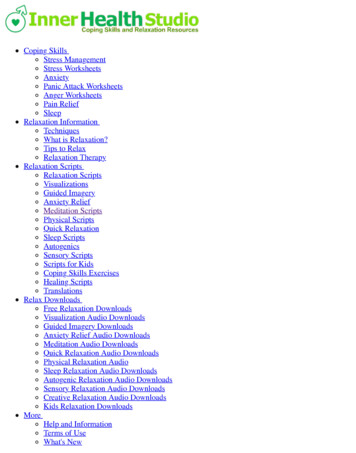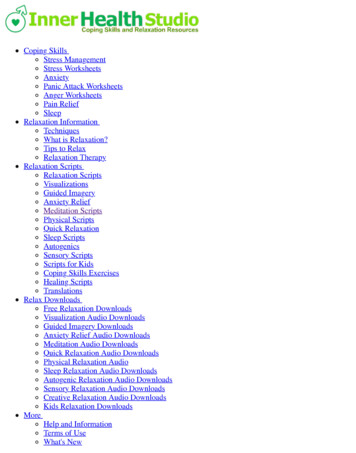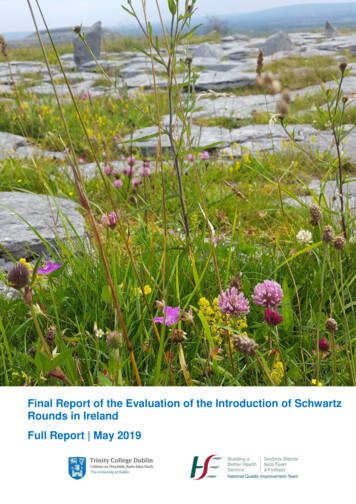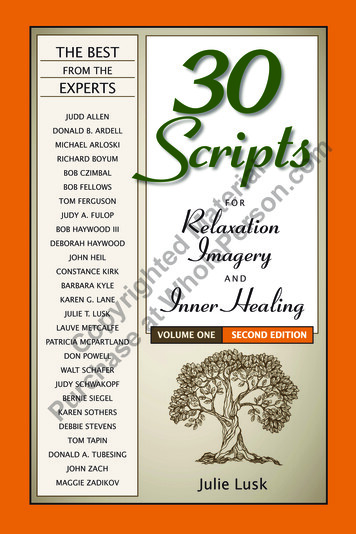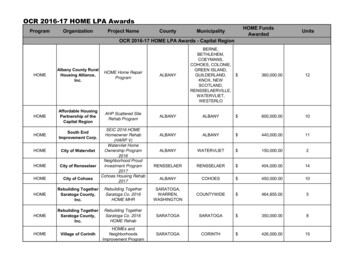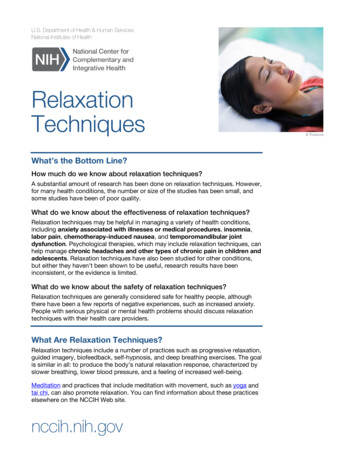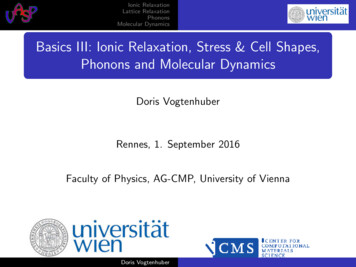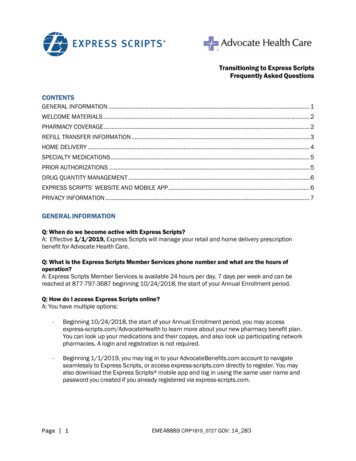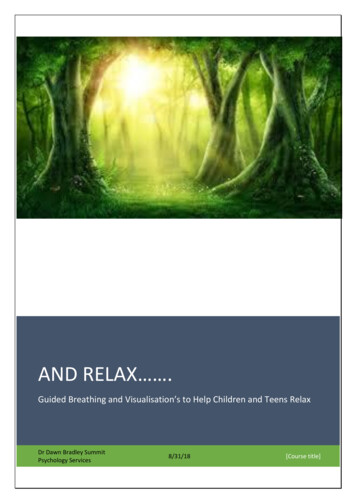
Transcription
AND RELAX .Guided Breathing and Visualisation’s to Help Children and Teens RelaxDr Dawn Bradley SummitPsychology Services8/31/18[Course title]
What is Relaxation?During a relaxation exercise (such asprogressive muscle relaxation, visualization,meditation, or another relaxationtechnique) muscle tension decreases, bloodpressure goes down, the mind becomescalm, and the harmful effects of prolongedstress are counteracted.The "relaxation response" is the opposite ofthe stress response.The stress response is also known as the fight-or-flight response. According toHerbert Benson, in his book "The Relaxation Response," we evoke the fight-or-flightresponse all the time, but "modern society does not socially accept the fighting orrunning naturally associated with it."This means that we are not appropriately using the fight-or-flight response forsurvival. We can't use the response as intended - imagine what would happen if youencountered a stressful situation, such as an argument at work, and responded byphysically fighting or running away? That does not work very well.The sympathetic nervous system is activated when we are in fight-or-flight mode.Over time this can have all kinds of negative effects (which are the symptoms ofstress).Benson says, "there is another response that leads to a quieting of the same nervoussystem." This other response is the Relaxation Response.The relaxation response is associated with physiological changes that are theopposite to the changes seen with the fight-or-flight response. The relaxationresponse can be evoked using relaxation techniques, such as autogenics, progressivemuscle relaxation, and meditation.Regularly inducing the relaxation response is most effective in improving day to dayliving, and results in increased control over the body's responses to stress.According to Benson, meditation results in changes in oxygen consumption, brainwaves, lactate levels, etc - all indicating lowered activity of the sympathetic nervoussystem. The heart rate decreases by an average of 3 beats per minute and therespiration rate decreases. A restful state is achieved.During meditation or other relaxation techniques, the subject may not actually feelmuch different or notice any changes. The physiological changes are occurring,Compiled by, Dr Dawn Bradley: Summit Psychology Services: www.summitpsychologyservices.co.uk1
nonetheless. This means that whether or not you notice any changes at the time, bydoing relaxation techniques you get all of the physical and psychological benefits ofthe relaxation response and are protected against the harmful effects of stress.What is Relaxation Therapy?When the average person is awake, many thoughts are going through his or hermind. The waking mind is very active.During sleep, the mind can remain active, though the rhythm is slower than that ofthe mind when awake. Have you ever slept for a full night, but awoke still feelingtired? When the mind is active, sleep is not always restful.The aim of relaxation therapy is to quiet the mind; to allow thoughts to flow in asmooth, level rhythm, and induce the relaxation response. This mental quiet allowsfor rest and rejuvenation that does not always occur, even during sleep.Relaxation therapy does not attempt to empty the mind, since it is not possible tothink of nothing. In relaxation, we focus the mind, and relax both mind and body.Tips to Optimize Your Success with Relaxation:1. Adopt a passive attitude. Approach relaxation with a "let it be" perspective.Don't try to make anything happen.2. Relax in a quiet environment with few distractions. As you become morefamiliar with relaxation and practiced in various techniques, you will learn to relaxanywhere. To begin, however, choose an environment that is free of distractions.3. Make sure you are in a setting that does not require your outside attention (keepyourself safe).4. Make yourself comfortable. Position yourself on chair with neck and backsupport, a firm bed, or a comfortable mat on the floor. Make sure the room is warm,not too hot or too cool. Choose a comfortable position that you can maintain for atleast 10 minutes.5. Start with short relaxation sessions, about 5 minutes. With more experience,achieving relaxation will become easier and you will be able to relax for longerperiods of time. With practice, 20 or 30 minutes is quite reasonable, and you maywish to relax for even longer sessions.6. Relaxation is a skill that must be learned. Practice often - every day is best!7. Set aside time to relax each day. Some people prefer to relax right before bedto help fall asleep. Others relax first thing in the morning to start the day refreshedand revitalized. Consider if there are times in the day when your stress level is high,Compiled by, Dr Dawn Bradley: Summit Psychology Services: www.summitpsychologyservices.co.uk2
or your energy is low. These can be ideal times to schedule in a brief relaxationsession.8. Keep experimenting! No one method of relaxation will work for everyone. It isimportant to try out different strategies to see which ones meet your needs. There isno right or wrong way to relax. Try our quiz to find out which techniques may workfor you.Compiled by, Dr Dawn Bradley: Summit Psychology Services: www.summitpsychologyservices.co.uk3
Some Relaxation ScriptsGeneralGet ready to relax. You can sit in a chair or lie down on a bed.Close your eyes and take a deep breath in. now breathe out.Breathe in. and breathe out.Keep breathing slowly like this. Feel how it relaxes you to breathe deeply.Now squeeze your hands closed into fists. Pretend that you are squeezing a ball ineach hand. gripping tighter. squeeze even tighter. Right now, your muscles aretense.And now relax. Let your hands go limp. Now your hands feel relaxed. See howrelaxed your hands feel. See how tense feels different from relaxed. Relaxation is away to make your whole body feel relaxed like your hands are now.One way to relax your body is by breathing deeply. Imagine that your body is like aballoon. When you breathe in, feel your chest and sides expanding, like a balloonfilling with air. When you breathe out, imagine your body is like a balloon shrinkingwith the air being let out.Breathe in like a balloon being blown up. Now breathe out, like the air is being letout of a balloon. Let the air out by blowing the air through your mouth.Breathe in through your nose, imagining your body expanding like a balloon. andnow imagine letting the end of the balloon go, and the air rushing out as you breatheout through your mouth.As you breathe in this time, raise your arms above your head. When you breatheout, lower your arms.Breathe in. Reach your hands above your head, stretching high up. stretching.and now lower your arms to your sides and relax. Breathe out.Raise your arms and breathe in. lower your arms and breathe out.Raise your arms and breathe in. lower your arms and breathe out.Now relax and keep your arms at your sides, while you continue breathing slowlyand deeply.Compiled by, Dr Dawn Bradley: Summit Psychology Services: www.summitpsychologyservices.co.uk4
Remember the difference between tense and relaxed. Tighten your leg muscles tomake both of your legs tense. Squeeze tighter. tighter. and now relax.Let your legs become very relaxed. Each leg is as floppy as a piece of string.Your legs feel heavy. The muscles are loose.Now tense your arms. Make the muscles very tight and tense. Tighter. and nowrelax. Your arms are relaxed, limp and loose as pieces of string.See how it feels to be relaxed. Your legs and arms are relaxed.Now let your whole body become relaxed. See how relaxed you can make yourbody. loosening every muscle. no tension at all.Your body feels heavy and relaxed.Relax even more by noticing your breathing again. See how calm your breathing is.In. and out. in. and out.Keep breathing and simply relax. There is nothing you need to do right now exceptrelax quietly.(pause)See how calm and relaxed you feel. It feels good to relax.Your relaxation time is finished now, and it is time to return to your usual activities.Keep your eyes closed for a little longer while you wake up your body and your mindby wiggling your fingers and toes. moving your arms and legs.Sit still now for a moment and open your eyes to look around the room.When you are ready, get up and return to your usual activities, feeling awake, butstill feeling relaxed and calm.Compiled by, Dr Dawn Bradley: Summit Psychology Services: www.summitpsychologyservices.co.uk5
Breathing RelaxationLet's relax right now. First, let your body relax a bit. Reach up, high above yourhead, stretching your arms. stretching your body very tall. Now let your arms relax.Place them at your sides, loosely.Do the same thing again, but this time, breathe in as you reach up. Stretch. andnow breathe out as you relax and place your arms at your sides.One more stretch, arms up, breathing in. and relax, arms down, breathing out.Just sit now, letting your arms rest at your sides.See how your breathing can relax you by taking slow, deep breaths. Breathe in.hold your breath. and now breathe out, slowly. Breathe in. and out.Keep breathing deeply and slowly.Continue the breathing relaxation for children.Place one hand on your chest and one hand on your stomach. Feel both of yourhands moving up and out as you breathe in. and down as you breathe out. Feelyour hands moving with your chest and stomach, gently moving in and out with eachbreath.(pause)Now rest your hands at your sides as you notice the ways you can breathe. Continuethe breathing relaxation for children.Imagine that there is a candle in front of you. You can even hold up one finger infront of your mouth and pretend it is a candle, if you like. As you breathe out, blowthe air out through your mouth very slowly. Feel the air on your finger. Imagine thatyou are blowing enough air to make the flame of the candle flicker, but not enoughto blow it out. You will need to blow very softly.When you breathe in, imagine that the flame of the candle flickers and leans towardyou. As you breathe out, the flame flickers and leans away.Imagine the flame of the candle moving in and out with each breath you take.Continue the breathing relaxation for children.(pause)Another way your breathing can relax you is to breathe like different animals. Do youknow how a dog pants? Breathe in. and now as you breathe out, pant, ha ha ha haha ha ha. Breathe in. pant, ha ha ha ha ha. Breathe in. pant.Compiled by, Dr Dawn Bradley: Summit Psychology Services: www.summitpsychologyservices.co.uk6
Imagine that you are like a cat purring. Breathe in. and as you breathe out, purr.Breathe in. purr. Breathe in. purr.Now as you breathe, you can sigh, and relax. Breathe in. and sigh as you breatheout. Breathe in. sigh. Breathe in. sigh.Just relax now for a moment, feeling your body relax. Your arms and legs are veryloose and relaxed. Continue the breathing relaxation for children.Now you can imagine that your body is like a balloon filling up as you breathe in andemptying as you breathe out. Let your ribs expand out to the sides, like a balloon,expanding. and then let the air out, like a balloon that is emptying. The balloonexpands. and then the air goes out.You can even imagine that you are blowing up a balloon. Imagine that you breatheair into your lungs, and then when you breathe out through your mouth, imaginethat you are blowing up a balloon. Each breath you blow out makes the balloon geteven bigger. Imagine filing the balloon as it gets bigger and bigger with each breathout. Breathe in. and then blow up the balloon even more. Bigger. bigger. bigger.Imagine letting go of the balloon, so it flies around the room as the air escapes. Feelyour body relaxing just like a limp, empty balloon. Continue the breathing relaxationfor children.And now, see how slowly you can breathe out. First breathe in. and now breatheout very slowly. out. out. out. When you can't breathe out any more air, breathein again, and then very slowly breathe out.For the next few moments, just relax, resting. It feels good to relax. Enjoy this calmfeeling.(pause)Now you are finished this breathing relaxation for children. Stretch your muscles ifyou want to, and let your body wake up. When you are totally awake, you can getback to the rest of your day.Compiled by, Dr Dawn Bradley: Summit Psychology Services: www.summitpsychologyservices.co.uk7
Creative RelaxationBegin by placing a blank sheet of paper and a box of coloured pencils on a cleantabletop. Play music that you find relaxing, calming, or energising. The type of musicyou select is up to you.Sit down at the table. Place your hands, palms down, on the tabletop. Close youreyes and take a deep breath in. and now exhale slowly, releasing the tension inyour body.Picture the tension in your body and the stressful thoughts in your mind. If thisstress were a colour, what colour might it be?Open your eyes, and select the colour, or colours, of your stress from the box ofcoloured pencils.Allow the creative expression relaxation to begin as you place the tip of the pencilanywhere on the paper and begin to move your hand and arm. Scribble out thetension. Scribble away the stress. It doesn't matter what the scribble looks like. Allowthe lines and shapes you are drawing to represent your stress and tension.Feel the movement of your arm releasing the stress and tension onto the paper. Feelthe tension in your body moving down your upper arm, lower arm, wrist, and hand.through your fingers, and into the pencil. The stress and tension in your day are heldinside the pencil, and as the pencil contacts the paper, the tension, stress, andworries are left behind on the page.Keep moving the pencil across the page. You may choose to change colours or usemore than one pencil at the same time. You may want to draw with both hands.Keep moving. Keep filling the paper with marks, shapes and lines.Feel the tension draining from your body and out onto the paper.Continue this exercise until you feel like some of the tension has left your body, oruntil what you see on the paper to represent your stress is complete.When you are finished drawing your stress, turn over the paper.Now imagine that on the top of your head is a string, holding you gently upright.Imagine the string tightening, lengthening your spine until your back is straight. Feelyour shoulders lowering slightly as the muscles in your neck and back becomesmooth and relaxed. Keep your posture upright and straight, but not rigid. Maintainthe natural curves in your spine.Breathe in again, drawing in a deep, relaxing breath.Breathe out tension.Compiled by, Dr Dawn Bradley: Summit Psychology Services: www.summitpsychologyservices.co.uk8
Breathe in relaxation.And breathe out tension.Allow each part of your body to relax. Picture the feeling of relaxation rising fromyour feet, all the way to your head. Allow your feet to relax. Feel your legs becomingwarm and heavy. Relax your hips, stomach, back, and chest. Relax your arms andshoulders. Relax your neck. Relax your face and head.Breathe in relaxation.breathe out tension.Breathe in, I am calm.Exhale, I am relaxed.I am calm.I am relaxed.Picture this feeling of calm and relaxation in your mind. If this tranquillity were acolour, what colour might it be?Select the colour or colours that represent this serenity.Allow the pencil you have chosen to contact the paper. Feel the creative expressionof relaxation flowing throughout your body. Begin to move the pencil in a gentle,calm rhythm. Use the movement of drawing, and the feel of drawing to express therelaxation.As the relaxation flows across the page, notice that your mind is becoming tranquiland relaxed. Focus on the movement of your body. Notice the tip of the pencilmoving along the paper smoothly. See the calm markings left on the page. Feel thecreative expression relaxation flowing through your body and your mind.Allow yourself to be totally focused on and absorbed in the creative process. Create apicture of the expression of relaxation. Feel the relaxation as you see the relaxationdeveloping on the page.Feel tension flowing out through the pencil, and relaxation flowing in with eachmovement of the pencil on paper. As your drawing grows, the feeling of relaxationincreases.Enjoy your creativity. Enjoy your creative expression relaxation.Allow your creative expression and relaxation to flow.Compiled by, Dr Dawn Bradley: Summit Psychology Services: www.summitpsychologyservices.co.uk9
Draw or scribble freely. Allow your body to move calmly, unrestricted, as youexperience the relaxation of creativity. Free yourself from expectations about thework you are creating. It doesn't matter what it looks like. Appreciate the process.Experience creativity. Allow your creative expression relaxation and revitalization.Breathe in relaxation.Breathe out tension.Breathe in relaxation.Draw away tension.Draw in relaxation.Draw out relaxation.Draw in relaxation.Draw relaxation.Draw relaxation.Continue to draw for as long as you wish. Enjoy the feeling of creative expressionand relaxation.Compiled by, Dr Dawn Bradley: Summit Psychology Services: www.summitpsychologyservices.co.uk10
Stretch and RelaxIn this stretch and relax script, we will begin with the most important key areas torelease tension, and then proceed to stretch muscle groups from the feet upward.Take a deep breath in. hold. and breathe out, releasing tension. Continue tobreathe rhythmically throughout these exercises.The first key area to stretch and relax is the neck and shoulders.Turn your head to the right - gently looking over your right shoulder .Breathe in. and out.Now return to centre.Turn your head to the left. Breathe in as you look over your left shoulder. andout as you return to centre.Turn again to the right. now back to centre. and turn to the left. and back tocentre.Take a deep breath in.Facing straight ahead, exhale as you look down. bringing your chin toward yourchest. down. down. allow the muscles on the back of your neck to lengthen.allow your head to hang forward, gently stretching the muscles. breathing slowly inand out.Now raise your chin and look straight ahead again.Breathe in as you look up. up. raise your chin up as you gaze toward theceiling. as you exhale, feel the muscles along the front of your neck lengthen in apleasant stretch and relax.Relax your head backward and continue to look toward the sky. Breathe in and out.Stretch and relax.Now return your head to a neutral position, facing forward.Breathe in.Look down one more time. Exhale as you allow the weight of your head to gentlystretch the muscles of your neck as you relax your head forward. No force isneeded to assume this position. just relax into this position of looking down withyour chin toward your chest. continue breathing gently as you feel your neckmuscles relaxing further. no longer able to remain tightened or tense.Return to neutral, facing forward.Compiled by, Dr Dawn Bradley: Summit Psychology Services: www.summitpsychologyservices.co.uk11
And now inhale as you look up again. relax your head back. feel the length ofyour neck, stretching out your muscles gently. Exhale.Return to neutral.Inhale bring your shoulders up toward your ears. Raise them up high. and thenlower your shoulders as you exhale.Raise your shoulders again in a shrug. and lower them, allowing the muscles downthe sides of your neck and the top of your shoulders to lengthen and give up thetension they were holding.Roll your shoulders in forward circles. rotate. rotate. rotate. and now changedirections. circle your shoulders back. rotate. rotate. rotate your shoulders.Rest your shoulders now. Feel how much more relaxed your shoulders feel.Now breathe in through your mouth as you stretch your jaw by opening your mouthwide. as wide as you can. feel the muscles stretching. exhale and relax. closeyour mouth but let your jaw drop slightly so your teeth are not touching. let yourjaw be loose and relaxed.The last key area to stretch and relax to relieve tension is your hands. Clench yourhands into tight fists. hold. and relax. Let your hands be limp.Now open your hands wide. wider. stretching your fingers out wide. bring yourarms forward and out to the sides, raising them above your head. Breathe in. andnow breathe out as you relax your arms and hands, releasing the tension and lettingthem go limp. Shake out the tension as you gently shake both arms.You have now stretched out the main areas where tension tends to accumulate.Proceed to stretch and relax further, moving from the feet upwards.Breathe in. and out.Continue slow, gentle breathing.Point your right toes, feeling the calf muscle tighten, and the front of your shinstretching. Now place your heel on the floor and bring your right foot toward yourright shin to stretch the back of the lower leg. To stretch even further, lean slightlyforward at the hips and bend your left leg to bring your centre of gravity toward thefloor. Feel the stretch up into your right hamstring.Now release your right leg back to neutral and point your left toe. Stretch themuscles on the front of your left lower leg. Now put your left heel on the floor andpoint your left toes upward, stretching the back of the left lower leg. Lean forward alittle, bending at the hips and right knee, to further stretch the calf and lefthamstring.Compiled by, Dr Dawn Bradley: Summit Psychology Services: www.summitpsychologyservices.co.uk12
Stretch and relax. Release your left leg to neutral.Breathe in. and out.To stretch the thigh muscles, support yourself by placing your left hand on a wall,chair back, or other stable surface, and then bend your right knee and grasp yourright foot in your hand. Feel the quadriceps on the front of your thigh stretching.Hold. and now release. Slowly place your right foot back on the floor. Switch sides.Bend your left knee and grasp your left foot behind you in your hand. Stretch thefront of the left thigh. Hold. and release.With both feet on the floor, shoulder width apart, and hands on your hips, breathein. Now exhale as you lean gently left. only until you feel a slight stretch at yourwaist on the right side. Hold. and now inhale and return to centre.Now breathe out as you lean slightly to the right. feel a gentle stretch on your leftside. Hold. and now inhale and release. Exhale.Breathe in. and out.Now gently grasp your hands behind you, with your arms straight. Breathe in as youbring both hands toward the back, away from the body. Bring your shoulder bladesin toward each other. Feel the space between your collarbones widening andstretching. Hold this. stretch and relax . and now let go. Breathe out. Shake itout. Shake both arms gently and feel them relax.Breathe in. Gently and slowly curve your spine by leaning your head forward anddown. breathe out as you tighten your abdominal muscles and feel your backmaking a slight C-shape. Now breathe in as you return to neutral. Feel the neutral Scurve of your spine. Exhale. Now inhale and look up toward the ceiling. Arch yourback slightly - just a little - exaggerating the curve in your lower back a bit. Exhaleand return to neutral.Breathe in. and out as you tighten your abdominal muscles again, curving yourback forward. and then relax. Breathe in. and out. Return to neutral. Let yourback be relaxed with its natural curves. Stretch and relax.Take a breath as you reach your right arm up toward the ceiling, stretch high up,lengthening the entire right side of your body. Breathe out and relax. Return toneutral. Now inhale and reach your left hand up high, reaching for the ceiling,lengthening the left side of your body. Then exhale and return to neutral.Breathe in. and out.Continue to breathe slowly and gently.Bring your right arm across the front of your body, grasp your upper arm with yourleft hand, and gently stretch your right shoulder. Now relax. Bring your left armCompiled by, Dr Dawn Bradley: Summit Psychology Services: www.summitpsychologyservices.co.uk13
across, grasp the upper arm with your right hand, and stretch your left shoulder.Now relax. Shake both arms a bit and feel them relax further.Breathe in. Stretch both arms straight forward. breathe out. reach straight outto the sides at shoulder level. inhale and reach forward again. exhale and stretchyour arms back out to the sides. now inhale and reach up above your head.stretch and relax as you exhale. Shake your arms out.Scan your body for any areas of tension. Gently stretch and relax these areas orfocus on relaxing them passively, just by thinking about releasing the tension.Breathe in. and exhale any remaining tension.Breathe in. and release tension as you breathe out.Stretch your arms up above your head as you breathe in.Relax as you breathe out.Stretch up. breathe in.Relax. breathe out.Breathe in. and out.In. and out.Allow your whole body to feel relaxed.Sensory RelaxationCompiled by, Dr Dawn Bradley: Summit Psychology Services: www.summitpsychologyservices.co.uk14
To begin the sensory relaxation process, imagine that you are at the top of astairway. At the bottom of the stairway is a state of peace, calm, and relaxation.Notice how you are feeling right now, at the top of the stairway.Begin to descend the stairway, going down toward relaxation. down and down to astate of calm and relaxation.Picture yourself going slowly down the stairway, one step at a time. It is acomfortable, safe descent to a place of relaxation. Move down step by step, at yourown pace, becoming more and more relaxed with each step.You might even become a bit sleepy as you get closer and closer to relaxation. That'sokay. Allow your mind to drift and your body to relax, heavy and comfortable.Moving down the stairway, down, down. almost to the bottom now. when youreach the bottom, you will be pleasantly relaxed.Now that you are experiencing a feeling of relaxation, create a mental picture in yourmind of these relaxing visual images.Imagine looking at an entire field of flowers from a great distance. See the flowersgrowing all the way to the horizon, as far as you can see. Focus in closer and closeruntil you can focus on several blossoms at arm's length.Now imagine looking at one beautiful flower. See the colour of the flower in yourmind. See the petals, the leaves, the stem. Imagine looking at the flower from veryclose up. See the minute details of the flower including any texture in the petals,drops of water, grains of pollen.Create a new visual image in your mind now. imagine that you are looking at apiece of crystal. As the light shines on the crystal, a rainbow of colours appears. Thecrystal itself is transparent but becomes bathed in a variety of colours as light istransformed on its surfaces and within the crystal. See the shining colours.moving. ever changing. flowing. See the surfaces of the crystal and the lightshining upon them and reflecting off them. Are the surfaces smooth or rough?Rounded? Sharp? Imagine this beautiful piece of crystal. Picture turning and movingthe crystal to see the light play upon the crystal and radiate from it. Can you seethrough the crystal? What does that look like? Imagine looking at the colours,textures, and shape of the crystal.Let's move on now to one of the other senses - hearing.Can you imagine the sound of waves? Hear in your mind the sound of waveswashing to shore.What about the sounds of a park on a sunny day? You might hear birds singing,children playing, people talking, dogs barking, a splashing fountain. Imagine thesounds of the breeze blowing at the park. the sounds of a game of catch.Compiled by, Dr Dawn Bradley: Summit Psychology Services: www.summitpsychologyservices.co.uk15
laughter. the rhythmic thud of a ball as it is caught in a glove, thrown, and caughtin a glove again. What other sounds might you hear at the park?Now imagine a different sound. The sound of rain on a roof. Imagine the sound ofthe rain as each drop lands. You may hear the sound of a gentle rain, a fewscattered drops. Or you may hear a harder rain, the constant tap taps taps of manydrops landing together. Hear the sound of the rain.Now let's imagine the sense of smell.Can you imagine the scent of baking cookies?Imagine the smell of baking bread.The smell of a pine forest. Smell the pine trees. the soil. the smell of theoutdoors.Imagine the smell of a rose. Imagine the smell of the rose so clearly, it is as if thereis a rose right in front of you, and you have brought it close to your nose to inhale itssweet scent.Now, move on to imagine the sense of taste.Imagine placing a slice of lemon against your tongue. imagine the sour taste of thelemon if you were to bite into the slice.Now imagine the taste of something sweet - a candy, a cookie.Think of a food that you like. now imagine taking a bite of this food. Taste thefood.Let's imagine now the sense of touch.Picture an animal that you like - maybe a friendly dog, cat, or rabbit - with very softfur. Imagine stroking the animal. feel the soft fur on the palm of your hand.Imagine moving your hand along the sleek fur.Imagine now a tub of warm water that is big enough to place your feet in. Imagineplacing your bare feet into the tub of water. The water is pleasantly hot. Feel thewarm water on your feet, all the way up to your ankles.Think of holding an object in your hands that is very soft. perhaps a sponge.Imagine squeezing the sponge.Now think of an object that is hard. lik
Imagine that there is a candle in front of you. You can even hold up one finger in front of your mouth and pretend it is a candle, if you like. As you breathe out, blow the air out through your mouth very slowly. Feel the air on your finger. Imagine that you are blowing enough air to make the flame of the candle flicker, but not enough to blow .
